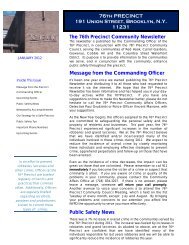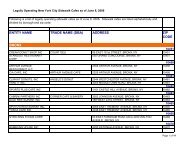Brooklyn Bridge Park Transportation Study, 3/2008
Brooklyn Bridge Park Transportation Study, 3/2008
Brooklyn Bridge Park Transportation Study, 3/2008
You also want an ePaper? Increase the reach of your titles
YUMPU automatically turns print PDFs into web optimized ePapers that Google loves.
Figure III-8 Proposed Pedestrian Access Improvements for the Atlantic Avenue Corridor<br />
SAm SChwARTz PLLC hDR-DANIEL FRANkFURT<br />
BROOKLYN<br />
BRIDGE PARK<br />
FURMAN ST<br />
COLUMBIA ST<br />
BQE RAMP<br />
BQE SB<br />
BQE NB<br />
BQE RAMP<br />
ATLANTIC AV<br />
BROOKLYN BRIDGE PARK TRANSPORTATION AND ACCESS STUDY 1<br />
Conclusion<br />
As Old Fulton Street and Atlantic Avenue are the two primary entrances to the <strong>Park</strong><br />
where the majority of visitors will experience the <strong>Park</strong> as pedestrians, the pedestrian<br />
routes along these two corridors should be improved. The planned reconstruction of<br />
the BQE cantilever presents a unique opportunity to reconfigure the approaches to<br />
the highway to significantly improve the pedestrian experience. Intersections should<br />
be normalized along Old Fulton Street at the BQE exit ramp, Front Street, Water Street,<br />
and Hicks Street. Along Atlantic Avenue, intersections should be normalized at the<br />
on- and off-ramps of the BQE, Columbia Street, and Furman Street. Pedestrian crossing<br />
lengths should be shortened where possible, unnecessary vehicle space reclaimed for<br />
pedestrians, and irregularly shaped intersections re-aligned to normal, right-angled,<br />
four-leg intersections.<br />
To realize the improvements suggested above, a detailed traffic analysis will be required<br />
to assess the potential impacts to vehicular level of service on the streets in question<br />
as well as the surrounding roadway network. This study would have to be coordinated<br />
with the New York City Department of <strong>Transportation</strong> (NYC DOT) and the New York<br />
State Department of <strong>Transportation</strong> (NYS DOT). Further discussion with NYS DOT and<br />
structural engineers would also be required to determine the feasibility of altering BQE<br />
ramp locations, as well as other improvements to the BQE cantilever structure. The<br />
proposed BQE cantilever reconstruction project presents a potential opportunity of<br />
further exploring these options with NYS DOT. Coordination with other local studies<br />
and projects (for example, the <strong>Brooklyn</strong> Greenway Initiative’s (BGI) greenway along<br />
<strong>Brooklyn</strong>’s waterfront and Community Consulting Service’s ramp from the <strong>Brooklyn</strong><br />
<strong>Bridge</strong>) could also help make a case for the implementation of design solutions<br />
described above as well as other long-term, far-reaching solutions, some of which were<br />
suggested by the community and described previously. However, opportunities also<br />
exist for making short-term, low-cost improvements at these locations. For example,<br />
proposed geometric changes can be installed through paint and temporary structures<br />
to test the designs. Due to their temporary nature, these could be implemented with<br />
far less agency coordination and background study.




